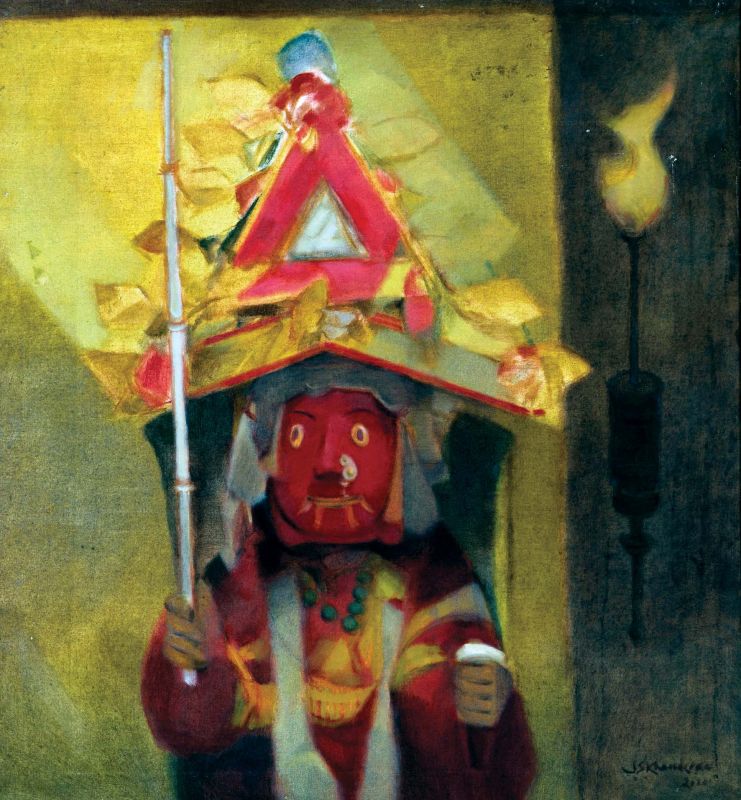Through the \"Broken Glass\" a window into the inner Khanderao

The National Gallery of Modern Art is hosting a retrospective show of artist J S Khanderao titled, ‘Through the Broken Window’. In many ways, it seems apt because for the longest time the name of Khanderao was synonymous with landscapes. And the NGMA, set in a sprawling green expanse is the perfect setting for the septuagenarian’s enormous body of work done over fifty years.
Revelling in the memory of his journey, he tells you how he started painting when he was in the fifth grade thanks to an encouraging art teacher, but how it was his stints at the Nutan Kalamandir in Gulbarga and the J J School of Art that actually trained him to perfect his skills and technique. “The then Art and Craft Director, who was in his early sixties looked at my works and urged me to start a fine art college in Gulbarga. At that time, my father was also insisting that I return home.” In 1965, the Ideal Fine Art Institute opened its doors, with Khanderao as its founder, Principal and the sole teacher for seven long years. This stint as the teacher defined his role as an artist. If today, the artist said, he is recognised for his expertise in portraiture, landscapes, abstracts, still life and water colours, it is mainly because he had to teach all these subjects to his students. “I had trained myself well in all these genres so I became near perfect in them.” Later, he handed over the reins to others and went on to teach at other institutes.

In the NGMA gallery, there is a cluster of 10 to 15 easels with medium sized portraits displayed on them. These are a departure from the large, detailed and realistic portraits displayed on the walls. The latter were commissioned projects apart from a portrait of his father and took him considerable time to complete.
Interestingly, the mostly Kannada speaking artist calls his portraits, ‘bhava chitragalu’ or pictures with emotions. “Without emotions, a portrait isn’t a portrait,” he declared. Pointing out to the portraits on the easels, he said they were done in short durations of an hour or so during the various demonstrations he would give at various colleges and art institutions. Some of these demo camps were initiated by him when he was the Chairman of the Karnataka Lalithakala Academy. These portraits are less detailed but convey the emotions just as well. “The main requirement for an artist is drawing,” he said. “Later on, they have to develop their own style and language. My language is predominantly line, form and colour.”
On display are paintings inspired by folk traditions of Karnataka. For a commission by the government, Khanderao offered to do an ‘exploration and documentation’ of fourteen folk customs of North Karnataka. These works are part of his identity as an artist.
We now move on to one of his famous paintings, Broken Glass. A wonderful composition of an abstract world through a broken glass pane is guaranteed to draw every visitor’s attention. In acknowledgement of its sheer force of appeal, the gallery has even placed a bench in front of the painting, inviting a longer study. This painting had won the first prize in 1968 from the Lalithakala Academy at its annual completion. Currently in its collection, the painting is one from Khanderao’s series of Windows.
He recounted the incident that actually triggered off the series. “I was walking home after a late night movie and happened to see a house with a lit window. The interior of the room was a picture of abstraction as the glass pane was not transparent. The reflection and refraction created by various lighting, be it natural or tube light, created abstract images.”
These works have a transparency which is unusual in an oil painting. Khanderao talks fondly of the doyen of Karnataka art world, the iconic artist K K Hebbar who nudged him into experimenting with oil paints. In 1982, the artist had participated at a National art camp at the Chitrakala Parishath which saw the participation of 50 artists from across India. K K Hebbar was one of the camp directors. “Hebbar would go on rounds to observe the works of all the artists,” he said. “After he observed my working, he called me aside and told me to continue with the technique that I was using and in fact, do further study.”
Khanderao was doing an abstract then and was trying out various ways to create transparency. In the series of abstracts displayed, mainly from the Windows series, the paint layers are super thin and luminescent. The palette favours mainly warm colours especially hues of yellow. “Encouraged by Hebbar, I started off with monochromes,” he explained. “Warm colours like yellow were easy to create transparency. Slowly, I created the same affect with two colours. Now, I am proficient in multi colours.”
Practice makes perfect was the motto of his entire life as an artist. In spite of being an art lecturer for almost thirty years, he ensured that he painted for about 5-6 hours every day, be it demonstrating a technique or doing a complete work. “Today, I paint about three hours daily,” he commented. “Without practise, an artist cannot be a good one.”
What: Through the Broken Window
When: 11am - 6.30pm, till Jan 15th
Where: National Gallery of Modern Art

